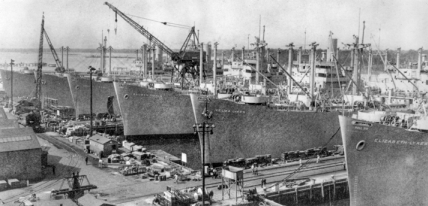See also: Zebulon B. Vance, USS; Shipbuilding

Liberty ships, a number of which were built in Wilmington, carried two-thirds of U.S. cargo during World War II, thus playing a significant role in the Allied cause as merchant vessels. According to standards developed by the U.S. Maritime Commission in 1940, Liberty ships were 440 feet long, 66 feet wide, and, with 2,500 horsepower, capable of cruising at 11 knots. Some were armed. These ships were the first vessels to be mass-produced using welding instead of riveting; welding was faster, cheaper, and lighter, and it took less time to train welders than riveters. Consequently, the ships became known for their rapid production. Nationally, over 2,700 Liberty ships were built and about 200 were sunk by the enemy.
Between 1941 and 1946 the North Carolina Shipbuilding Corporation in Wilmington produced 243 vessels, of which 125 were Liberty ships. In 1943, 20,000 workers were involved in this effort. Many of these Liberty ships were named for famous North Carolinians and for cities and counties that conducted war bond drives. On 6 Dec. 1941 the USS Zebulon B. Vance was the first Liberty ship launched in Wilmington, just hours before the attack on Pearl Harbor. The Vance made several successful runs to London before being damaged by a mine on a return trip; it was repaired and rejoined the Liberty fleet. Later the Vance was converted to a hospital ship and renamed the USS John J. Meany. Finally, it was reconverted back to the Vance to transport "war-bride" dependents of American military personnel to the United States.
After the war, a number of Liberty ships became merchant vessels and others were stored for future use. Most were subsequently scrapped. In the early 2000s two restored and functioning Liberty ships remained: the USS Jeremiah O'Brien on the West Coast and the USS John W. Brown, moored in Baltimore, which visited Wilmington in 1996. As part of the North Carolina artificial reef program, the Liberty ship USS Theodore Parker was sunk in 50 feet of water just off Fort Macon near Morehead City and became a popular site for scuba divers and fishermen.